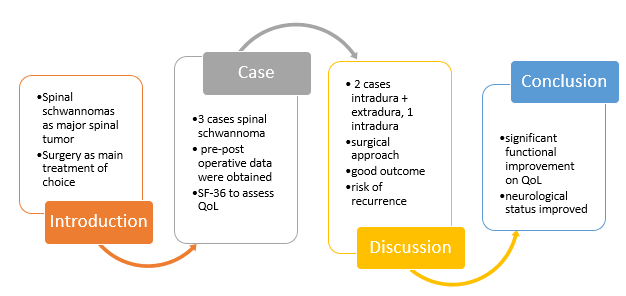[1] J. Lenzi, G. Anichini, A. Landi, A. Piciocchi, E. Passacantilli, F. Pedace, R. Delfini, A. Santoro, Spinal nerves schwannomas: experience on 367 cases—historic overview on how clinical, radiological, and surgical practices have changed over a course of 60 years,
Neurology Research International,
2017,
2017. [
Crossref], [
Google Scholar], [
Publisher]
[2] S. Tish, G. Habboub, M. Lang, Q.T. Ostrom, C. Kruchko, J.S. Barnholtz-Sloan, P.F. Recinos, V.R. Kshettry, The epidemiology of spinal schwannoma in the United States between 2006 and 2014,
Journal of Neurosurgery: Spine,
2019,
32, 661-666. [
Crossref], [
Google Scholar], [
Publisher]
[3] I. Sun, M.N. Pamir, Non-syndromic spinal schwannomas: a novel classification,
Frontiers in Neurology,
2017,
8, 269954. [
Crossref], [
Google Scholar], [
Publisher]
[4] A. Pokharel, T.S. Rao, P. Basnet, B. Pandey, N.J. Mayya, S. Jaiswal, Extradural cervical spinal schwannoma in a child: a case report and review of the literature,
Journal of Medical Case Reports,
2019,
13, 1-5. [
Crossref], [
Google Scholar], [
Publisher]
[5] K. Ando, S. Imagama, Z. Ito, K. Kobayashi, H. Yagi, T. Hida, K. Ito, M. Tsushima, Y. Ishikawa, N. Ishiguro, How do spinal schwannomas progress? The natural progression of spinal schwannomas on MRI,
Journal of Neurosurgery: Spine,
2016,
24, 155-159. [
Crossref], [
Google Scholar], [
Publisher]
[6] J. Crist, J.R. Hodge, M. Frick, F.P. Leung, E. Hsu, M.T. Gi, S.K. Venkatesh, Magnetic resonance imaging appearance of schwannomas from head to toe: a pictorial review,
Journal of Clinical Imaging Science,
2017,
7. [
Crossref], [
Google Scholar], [
Publisher]
[7] R.R. Kalra, O.N. Gottfried, M.H. Schmidt, Spinal schwannomas: an updated review of surgical approaches,
Contemporary Neurosurgery,
2015,
37, 1-8. [
Crossref], [
Google Scholar], [
Publisher]
[8] K. Kobayashi, S. Imagama, K. Ando, T. Hida, K. Ito, M. Tsushima, Y. Ishikawa, A. Matsumoto, M. Morozumi, S. Tanaka, N. Ishiguro, Contrast MRI findings for spinal schwannoma as predictors of tumor proliferation and motor status,
Spine,
2017,
42, 150-155. [
Crossref], [
Google Scholar], [
Publisher]
[9] S. Matsuda, Y. Kajihara, M. Abiko, T. Mitsuhara, M. Takeda, V. Karlowee, S. Yamaguchi, V.J. Amatya, K. Kurisu, Concurrent schwannoma and meningioma arising in the same spinal level: a report of two cases,
NMC Case Report Journal,
2018,
5, 105-109. [
Crossref], [
Google Scholar], [
Publisher]
[10] S.E. Lee, T.A. Jahng, H.J. Kim, Different surgical approaches for spinal schwannoma: a single surgeon’s experience with 49 consecutive cases,
World Neurosurgery,
2015,
84, 1894-1902. [
Crossref], [
Google Scholar], [
Publisher]
[11] B. Li, J. Li, W. Miao, Y. Zhao, J. Jiao, Z. Wu, X. Yang, H.Wei, J. Xiao, Prognostic analysis of clinical and immunohistochemical factors for patients with spinal schwannoma,
World Neurosurgery,
2018,
120, 617-627. [
Crossref], [
Google Scholar], [
Publisher]
[12] K. Yamane, T. Takigawa, M. Tanaka, S. Osaki, Y. Sugimoto, T. Ozaki, Factors predicting clinical impairment after surgery for cervical spinal schwannoma,
Acta Medica Okayama,
2013,
67, 343-349. [
Crossref], [
Google Scholar], [
Publisher]
[13] A. Pompili, F. Caroli, F. Crispo, M. Giovannetti, L. Raus, A. Vidiri, S. Telera, Unilateral laminectomy approach for the removal of spinal meningiomas and schwannomas: impact on pain, spinal stability, and neurologic results,
World Neurosurgery,
2016,
85, 282-291. [
Crossref], [
Google Scholar], [
Publisher]
[14] Q. Deng, Z.Tian, W. Sheng, H. Guo, M.E. Dan, Surgical methods and efficacies for cervicothoracolumbar spinal schwannoma,
Experimental and Therapeutic Medicine,
2015,
10, 2023-2028. [
Crossref], [
Google Scholar], [
Publisher]
[15] C. Hohenberger, J. Hinterleitner, N.O. Schmidt, C. Doenitz, F. Zeman, K.M. Schebesch, Neurological outcome after resection of spinal schwannoma,
Clinical Neurology and Neurosurgery,
2020,
198, 106127. [
Crossref], [
Google Scholar], [
Publisher]
[16] T. Takahashi, T. Hirai, T. Yoshii, H. Inose, M. Yuasa, Y. Matsukura, S. Morishita, Y. Kobayashi, K. Utagawa, A. Kawabata, J. Hashimoto, Risk factors for recurrence and regrowth of spinal schwannoma,
Journal of Orthopaedic Science,
2023,
28, 554-559. [
Crossref], [
Google Scholar], [
Publisher]
[17] M. Sowash, O. Barzilai, S. Kahn, L. McLaughlin, P. Boland, M.H. Bilsky, I. Laufer, Clinical outcomes following resection of giant spinal schwannomas: a case series of 32 patients.
Journal of Neurosurgery: Spine,
2017,
26, 494-500. [
Crossref], [
Google Scholar], [
Publisher]


